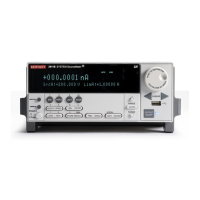System SourceMeter® Instrument Reference Manual Section 7:
2600BS-901-01 Rev. B / May 2013 7-201
Details
This function generates and activates new calibration constants for the given range.
The positive and negative polarities of the instrument must be calibrated separately. Use a positive value for
range to calibrate the positive polarity and a negative value for range to calibrate the negative polarity.
Typically, the two calibration points that are used are near zero for calibration point 1 and 90% of full scale for
calibration point 2.
All four measurements (cp1Measured, cp1Reference, cp2Measured, and cp2Reference) must be made
with the calibration set that is active. Corruption of the calibration constants may result if this is ignored.
The new calibration constants are activated immediately but they are not written to nonvolatile memory. Use
smuX.cal.save() to save the new constants to nonvolatile memory. The active calibration constants stay in
effect until the instrument is power cycled or a calibration set is loaded from nonvolatile memory with the
smuX.cal.restore() function.
This function is disabled until a successful call to smuX.cal.unlock() is made.
Example
smua.measure.calibratev(1, 1e-4, 1e-5, 0.92,
0.903)
SMU channel A calibrates voltage
measurement using following values: 1 V
calibration range, 1e−4 for +zero
measurement reading, 1e−5 for +zero
DMM measurement reading, 0.92 for
+FS
measurement reading, and 0.903 for
the +FS DMM measurement reading.
Also see
Adjustment (on page B-18)
smuX.cal.lock() (on page 7-186)
smuX.cal.restore() (on page 7-188)
smuX.cal.save() (on page 7-189)
smuX.cal.unlock() (on page 7-190)
smuX.source.calibrateY() (on page 7-218)
smuX.measure.count
This attribute sets the number of measurements performed when a measurement is requested.
Type TSP-Link accessible Affected by Where saved Default value
Attribute (RW) Yes
Instrument reset
SMU reset
Saved setup 1
Usage
count = smuX.measure.count
smuX.measure.count = count
Source-measure unit (SMU) channel (for example, smua.measure.count applies
to SMU channel A)

